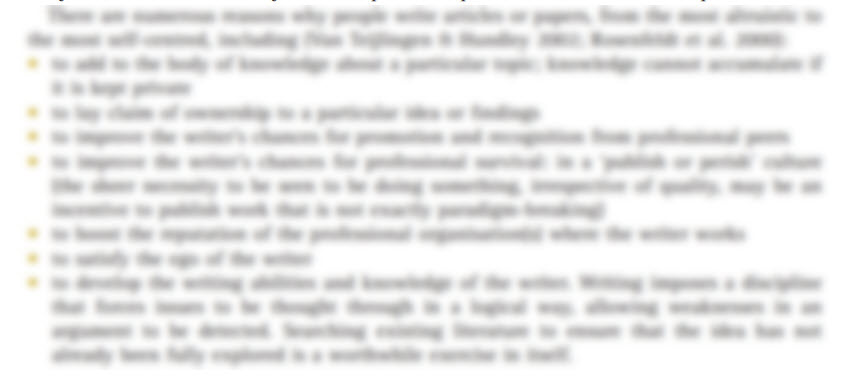Writing is a complex activity that needs planning
The planning process prior to science writing is often ad-hoc, limited or non-existent. If you are rushing for a deadline and keen to get started, it might be tempting to cut corners and skip the planning process all together. If your planning is limited to jotting down a title and a few key points before you start, you might find you lack focus when you do start.
As science writing is often a complex activity, it may need complex planning, whether you are writing about your own research or someone else’s. In order to produce a high-quality document, important decisions and specific planning is needed before you start writing, especially in relation to document design and identifying your target audience. Careful planning is also needed to avoid excessive rewrites and extensive editing.
DOWNLOAD THE CHECKLIST: Document Preparation Plan - Checklist
An effective plan needs to be prepared as a separate document
Careful planning involves thorough decision-making which takes time. Written plans are commonly prepared for scientific activities such as completing field work and lab work but the writing of a research report or paper is not usually given the same degree of planning effort. Not only should you plan before you start writing, your plan needs to be written into a coherent, separate document that you and your colleagues can refer to and update as you progress.
An effective plan will help you to get started and stay focused
Getting started is one of the most difficult obstacles to successful writing. A lack of planning can lead to inefficient writing in the early stages; for example, writing too much detail in some sections and not enough in others or spending too much time writing about an idea that will be cut out later. If you begin your writing with an effective plan, not only will it help you to get started, it will help you stay on track. A clear plan will allow yourself sufficient time to think about what you want to write and reduce the risk of producing a document that is difficult to read and understand.
An effective plan will help you collaborate with other writers
When writing with colleagues, planning is often undertaken through face-to-face discussions, emails and phone calls, without sufficient documentation. Preparing a written plan may significantly reduce time spent rewriting and redrafting when working with co-authors or if senior staff need to approve your drafts. There is nothing worse than spending hours writing and perfecting your thinking on a topic, only to have this work cast aside because a senior author has left important decisions on a document’s structure or purpose to the last minute. Once a written plan is agreed to, any changes can be monitored and implemented through regular reviews and updates, if necessary.
Traditionally, document plans focus upon content
Document plans are not new but usually focus upon what should be in the final version (e.g. report templates) and outline what the author should write to satisfy a project’s purpose and objectives. Planning the process of writing is also important.
What should be included in a document plan?
An effective document plan should consider how you might manage each stage of the writing process: pre-writing, drafting of ideas, editing and rewriting, and proofreading. A document plan should cover all design, preparation and production activities needed to successfully complete your document. I refer to this type of plan as a Document Preparation Plan that addresses key aspects of both document production (Part 1) and document design (Part 2). As with any plan, you should not expect it to be perfect. It will not be possible to predict exactly what will be written or exactly what is needed to manage all writing-related tasks. A Document Preparation Plan should be short and succinct and updated when necessary, depending upon the size of the writing project and whether co-authors are involved. It needn’t be written in complete paragraphs; bullet points may be all that is needed.
Part One. Document production
The first part of the planning process involves documenting all tasks that need to be managed in order to successfully complete a high-quality document. It can include how and when these tasks will be completed.
Factors to include:
- Outlining your purpose (reasons) for writing
- Identifying your target audience
- Listing all non-writing activities needed to complete the document and setting appropriate deadlines for each
- Listing all resources needed for all writing and non-writing activities
Part Two. Summary of document content & structure
This is the part of a document plan that most writers complete at the first stage of the writing process, but not always satisfactorily; many writers postpone developing their core message until the final stages of writing. However, it is crucial to decide what key messages you want to cover before you start writing including your aim or problem statement and key findings. Your key messages and overall conclusions may change as your progress through your writing, but completing this first step in the content planning process and gives you a firm framework on which to build your story.
Some factors to consider:
- Draft title and subtitle.
- The aim and problem statement.
- Summary of methods & results.
- Implications of the results and general conclusion(s).
- Document type (i.e. science report) & length.
- Type and number of visual aids (i.e. graphs, tables, diagrams).
To help you design a document preparation plan to suit your topic, I have developed a Document Preparation Plan (checklist) which is available as a download (pdf).
DOWNLOAD THE CHECKLIST: Document Preparation Plan - Checklist
Remember
- Plans are not meant to be perfect but act as a guide to your thinking and a framework to further develop the project you are working on.
- Keep all versions of your plans for future reference or use them as templates for future projects.
- Ask colleagues for feedback on your plans as well as your document drafts..
© Dr Marina Hurley 2020 www.writingclearscience.com.au
Any suggestions or comments please email info@writingclearscience.com.au
FURTHER READING
- Should we use active or passive voice?
- 10 writing tips for the struggling ESL science writer
- Co-authors should define their roles and responsibilities before they start writing
- How to write when you don’t feel like it
- When to cite and when not to
- Back to basics: science knowledge is gained while information is produced
- How to build and maintain confidence as a writer
- If science was perfect, it wouldn’t be science
- The essentials of science writing: What is science writing?
- 8 steps to writing your first draft
- Two ways to be an inefficient writer
- Work-procrastination: important stuff that keeps us from writing
Find out more about our new online course...
Now includes feedback on your writing Learn more...
SUBSCRIBE to the Writing Clear Science Newsletter
to keep informed about our latest blogs, webinars and writing courses.




